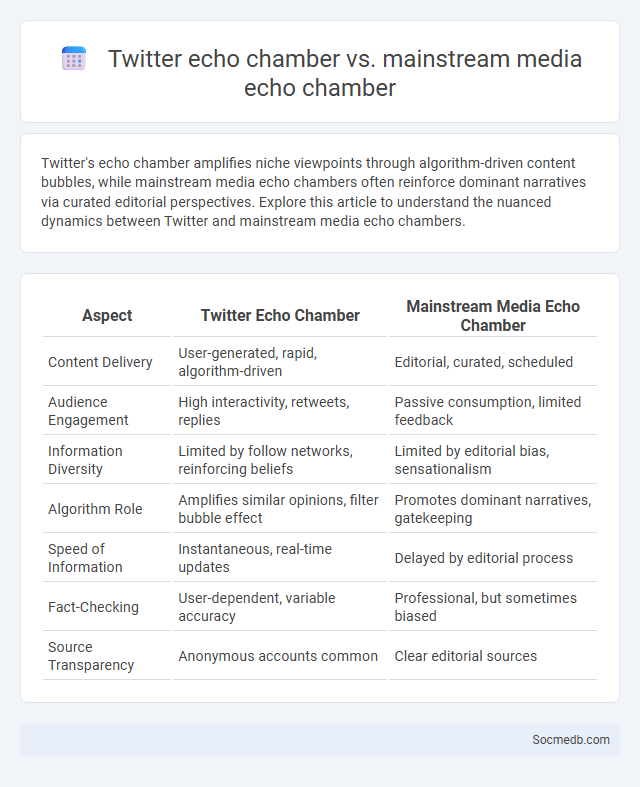
Photo illustration: Twitter echo chamber vs mainstream media echo chamber
Twitter's echo chamber amplifies niche viewpoints through algorithm-driven content bubbles, while mainstream media echo chambers often reinforce dominant narratives via curated editorial perspectives. Explore this article to understand the nuanced dynamics between Twitter and mainstream media echo chambers.
Table of Comparison
| Aspect | Twitter Echo Chamber | Mainstream Media Echo Chamber |
|---|---|---|
| Content Delivery | User-generated, rapid, algorithm-driven | Editorial, curated, scheduled |
| Audience Engagement | High interactivity, retweets, replies | Passive consumption, limited feedback |
| Information Diversity | Limited by follow networks, reinforcing beliefs | Limited by editorial bias, sensationalism |
| Algorithm Role | Amplifies similar opinions, filter bubble effect | Promotes dominant narratives, gatekeeping |
| Speed of Information | Instantaneous, real-time updates | Delayed by editorial process |
| Fact-Checking | User-dependent, variable accuracy | Professional, but sometimes biased |
| Source Transparency | Anonymous accounts common | Clear editorial sources |
Understanding the Concept of Echo Chambers
Echo chambers on social media occur when algorithms and user behavior create filtered environments, exposing Your feed only to information and opinions that reinforce existing beliefs. These insulated digital spaces limit diverse perspectives, amplifying confirmation bias and reducing critical thinking. Being aware of echo chambers helps You actively seek varied viewpoints to foster informed and balanced online interactions.
Twitter Echo Chamber: Features and Dynamics
The Twitter echo chamber is characterized by users engaging primarily with like-minded accounts, reinforcing existing beliefs through algorithms that promote similar content. This dynamic limits exposure to diverse perspectives, intensifying group polarization and confirmation bias. Understanding these features helps you navigate and critically assess the information within your Twitter network.
Mainstream Media Echo Chamber: Structure and Influence
The mainstream media echo chamber operates through repetitive content cycles, where major news outlets continuously share similar narratives, reinforcing specific viewpoints among audiences. This structure limits exposure to diverse perspectives, creating a feedback loop that amplifies dominant ideologies and diminishes critical discourse. The influence of this echo chamber shapes public opinion by prioritizing conformity over pluralistic debate, often driven by algorithmic curation and corporate interests in platforms like Facebook and Twitter.
Comparing Twitter and Mainstream Media Echo Chambers
Twitter often facilitates rapid information exchange within echo chambers by enabling users to follow like-minded accounts and engage in algorithm-driven content sharing, amplifying partisan perspectives. Mainstream media echo chambers tend to be shaped by editorial biases and targeted audience demographics, resulting in curated news that reinforces existing beliefs without the direct peer interaction found on Twitter. Both platforms contribute to information polarization but differ in mechanisms, with Twitter's real-time user interactions and mainstream media's controlled content production.
Algorithms and Personalization in Echo Chambers
Social media algorithms analyze Your behavior to curate personalized content that reinforces existing beliefs, often creating echo chambers that limit exposure to diverse perspectives. These algorithm-driven filters prioritize engagement by showing content aligned with Your preferences, which can amplify misinformation and polarize opinions. Understanding these mechanisms is crucial for navigating social platforms mindfully and seeking balanced information.
Impact of Echo Chambers on Public Opinion
Echo chambers on social media reinforce your existing beliefs by filtering content that aligns with your viewpoints, limiting exposure to diverse perspectives. This phenomenon polarizes public opinion, leading to increased division and misinformation within online communities. Understanding the impact of echo chambers is crucial for fostering critical thinking and promoting balanced discourse in digital spaces.
Misinformation and Polarization in Echo Chambers
Misinformation spreads rapidly on social media platforms, often amplified within echo chambers where users are exposed primarily to content that reinforces their existing beliefs. This selective exposure fosters polarization by creating isolated communities with little interaction across differing viewpoints. Protecting your perspectives requires critical evaluation of sources and active engagement with diverse information to break the cycle of misinformation and polarization.
Breaking Out of Echo Chambers: Challenges and Solutions
Breaking out of social media echo chambers requires recognizing algorithm-driven content loops that reinforce existing beliefs and limit exposure to diverse perspectives. Your engagement with varied sources and critical evaluation of information can disrupt these cycles, fostering a more balanced understanding of complex topics. Implementing platform features like content diversification tools and actively seeking opposing viewpoints helps mitigate confirmation bias and promotes healthier online discourse.
The Role of Confirmation Bias in Echo Chamber Formation
Confirmation bias significantly contributes to echo chamber formation on social media by driving users to seek and engage with content that aligns with their preexisting beliefs, reinforcing cognitive biases. Algorithms amplify this effect by curating feeds that prioritize similar viewpoints, thus limiting exposure to diverse perspectives and fostering ideological segregation. Studies reveal that this selective information consumption intensifies polarization and diminishes critical thinking among users within digital communities.
Strategies to Foster Open and Diverse Discourse
Encouraging diverse perspectives on social media platforms involves implementing algorithms that prioritize content from varied voices and promoting digital literacy to help users critically engage with information. Creating inclusive community guidelines and moderation practices ensures respectful dialogue while protecting freedom of expression. Platforms leveraging data analytics can identify and mitigate echo chambers, fostering an open environment where diverse opinions flourish.
 socmedb.com
socmedb.com